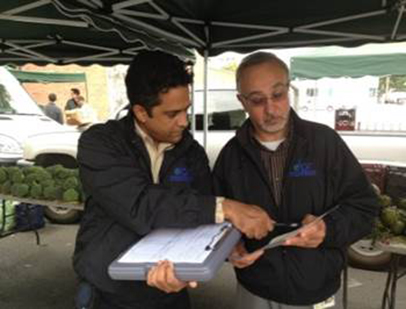More than 96 percent of the fruits and vegetables for sale last year in California met federal pesticide safety standards, according to residue test results released Wednesday by the California Department of Pesticide Regulation (DPR). The testing, using state-of-the-art equipment, was done by DPR scientists on 3,471 samples of produce, including 234 labeled as “organic,” which were collected in 2014 from grocery stores, farmers markets, food distribution centers and other outlets around the Golden State. 
- 93.43 percent of all produce samples (California grown and non-California grown) had pesticide residue levels that were legal (e.g., at, or below, EPA tolerances).
- Of those, 40.74 percent had no detectable residues at all, while 52.69 percent had residues detected within the legal tolerance level.
- 83.33 percent of the 234 produce items tested carrying the “organic” label had no detectable pesticide levels.
- 1.07 percent of the samples had pesticide residues in excess of the established tolerance level.
- An additional 5.5 percent of the samples had illegal traces of pesticides that were not approved for that commodity.
- Produce that most frequently tested positive for illegal pesticide residues in 2014 included ginger from China; cactus pads, cactus pears, limes, papaya, summer squash, tomatillos, chili peppers and tomatoes from Mexico, and spinach and kale from the United States.
 “This report further confirms that California’s vigorous pesticide regulatory program creates a reliable marketplace where consumers can have faith in their fresh fruits and vegetables,” said Brian Leahy, DPR director. “The pesticide rules and oversight we have in this state are effective at protecting the produce that we enjoy eating.” If DPR finds produce with illegal residues, the agency removes the item(s) from the chain of distribution to prevent it from reaching consumers and also attempts to trace the produce to its source. The tainted lots are quarantined.
“This report further confirms that California’s vigorous pesticide regulatory program creates a reliable marketplace where consumers can have faith in their fresh fruits and vegetables,” said Brian Leahy, DPR director. “The pesticide rules and oversight we have in this state are effective at protecting the produce that we enjoy eating.” If DPR finds produce with illegal residues, the agency removes the item(s) from the chain of distribution to prevent it from reaching consumers and also attempts to trace the produce to its source. The tainted lots are quarantined.  Businesses that violate California pesticide residue laws face the loss of their product and also possible fines. In December 2014, DPR imposed a $21,000 fine against a California produce importer with a history of recurring pesticide residue violations, mostly on produce imported from Mexico. (See DPH’s press release on Repeat Pesticide Offenders. Click here for a video about inspectors collecting samples and testing for pesticides.) DPR continues to find a small but significant number of cases of illegal residues on fresh produce from Mexico and other countries. To help address this, DPR enforcement staff gave presentations in 2014 about the department’s Pesticide Residue Monitoring Program to about 160 Mexican fruit and vegetable growers at workshops in Mexicali and Ensenada.
Businesses that violate California pesticide residue laws face the loss of their product and also possible fines. In December 2014, DPR imposed a $21,000 fine against a California produce importer with a history of recurring pesticide residue violations, mostly on produce imported from Mexico. (See DPH’s press release on Repeat Pesticide Offenders. Click here for a video about inspectors collecting samples and testing for pesticides.) DPR continues to find a small but significant number of cases of illegal residues on fresh produce from Mexico and other countries. To help address this, DPR enforcement staff gave presentations in 2014 about the department’s Pesticide Residue Monitoring Program to about 160 Mexican fruit and vegetable growers at workshops in Mexicali and Ensenada.
(To sign up for a free subscription to Food Safety News, click here.)
